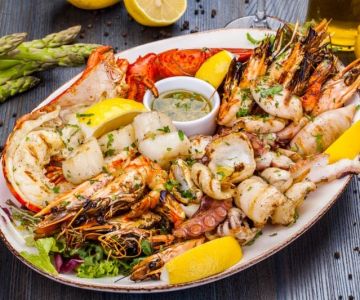
Your Ultimate Guide to Food Trends
- The Evolution of Food Trends
- Global Influences Shaping Modern Cuisine
- Wellness-Driven Eating Habits
- Technology and Social Media’s Impact on Food
- Sustainability and Ethical Food Movements
- Emerging Food Trends to Watch
1. The Evolution of Food Trends
Food trends are constantly evolving, reflecting changes in culture, technology, and even global consciousness. What was once considered a niche dietary choice—like plant-based eating or fermentation—has now become mainstream. From the avocado toast craze to the rise of functional foods, culinary trends tell stories about who we are and what we value.
In the early 2000s, food trends were often driven by celebrity chefs and restaurant culture. But today, the power has shifted toward social media and consumer-driven innovation. The average diner now influences food culture as much as professional critics do. At Brunch & Snack Chat, we explore these shifts to help readers discover how tastes evolve and how to experience them first-hand.

Casabianca Family Italian Ristorante And Pizzeria
New YorkNew York CountyNew York
854 10th Ave, New York, NY 10019, USA
2. Global Influences Shaping Modern Cuisine
Modern food trends are defined by cross-cultural fusion. The world’s kitchens have become interconnected through travel, migration, and digital media. From Korean BBQ tacos to matcha lattes, these culinary hybrids celebrate diversity while satisfying curiosity for new flavors.
Recent years have seen a surge in interest in regional authenticity. Diners now crave genuine experiences — whether it’s traditional Neapolitan pizza or Japanese omakase dining. This global exchange doesn’t just enrich menus; it expands how people understand identity through food. Food festivals and pop-up restaurants across the U.S. reflect this movement, bringing global flavors closer to local tables.
3. Wellness-Driven Eating Habits
Health and wellness trends continue to redefine how we eat. Today’s consumers are more conscious than ever of the relationship between food and well-being. Functional foods—those enhanced with vitamins, probiotics, or adaptogens—are gaining popularity among people who want more than just flavor; they want nourishment with purpose.
Plant-based diets, once a niche movement, have become a mainstream lifestyle. Beyond vegetarians, even meat-eaters are embracing flexitarian habits, choosing sustainable proteins like tofu, tempeh, and jackfruit. Meanwhile, fermented foods like kombucha, kimchi, and kefir have become staples in health-focused households. These choices reflect a growing understanding that eating well is not just about calorie counting—it’s about longevity and vitality.
For wellness-minded readers looking for new food inspiration or local spots to try, Brunch & Snack Chat regularly highlights emerging cafes, health brands, and food artisans leading the next wave of nutritious eating.
4. Technology and Social Media’s Impact on Food
Technology has revolutionized how we discover, prepare, and share food. Social media platforms like Instagram and TikTok have turned every meal into a visual experience. A single viral dish—like cloud bread or baked feta pasta—can spark nationwide demand overnight. This digital era has made food more accessible, interactive, and creative than ever before.
In addition to influencing trends, technology is reshaping how we cook. Smart kitchen appliances, meal kit services, and AI-generated recipes are simplifying gourmet experiences for home cooks. These innovations reflect a growing appetite for convenience without compromising creativity.
At Brunch & Snack Chat, we’ve seen how digital communities are redefining the food landscape. From influencers showcasing street eats to home bakers starting online micro-bakeries, the next culinary revolution might just start in your feed.
5. Sustainability and Ethical Food Movements
In 2025 and beyond, sustainability is no longer a fringe concern—it’s central to food innovation. Consumers want transparency about sourcing, packaging, and environmental impact. Restaurants are adopting zero-waste philosophies, and grocery stores are prioritizing local suppliers and eco-friendly alternatives.
Beyond environmental impact, ethical eating also involves fair labor practices and animal welfare. The growing popularity of farm-to-table dining and regenerative agriculture highlights this shift. Diners aren’t just asking how their food tastes—they’re asking where it comes from and who benefits from it.
For those interested in sustainable dining and conscious consumption, Brunch & Snack Chat curates guides on ethical eateries, responsible brands, and eco-friendly kitchen habits that make mindful eating accessible and enjoyable.
6. Emerging Food Trends to Watch
The future of food is a blend of innovation, nostalgia, and sustainability. Expect to see growth in areas like precision fermentation (lab-grown dairy), personalized nutrition apps, and “climate cuisine”—meals designed to minimize carbon footprints. There’s also a growing trend of returning to ancestral eating practices, celebrating indigenous ingredients and traditional cooking techniques.
Meanwhile, flavor exploration continues to expand. Regional spice blends, fermented condiments, and natural sweeteners are reshaping how chefs approach menu design. Even comfort foods are being reimagined with a health-conscious twist — think low-carb pizzas, gluten-free pastries, and probiotic-rich sauces.
For food enthusiasts eager to stay ahead of the curve, Brunch & Snack Chat offers insights, interviews, and local guides that spotlight what’s next in the culinary world — helping readers experience trends before they hit the mainstream.








 Roberto's Pizza & Pasta4.0 (177 reviews)
Roberto's Pizza & Pasta4.0 (177 reviews) Glaze Teriyaki4.0 (139 reviews)
Glaze Teriyaki4.0 (139 reviews) Trattoria iL Gusto Wine Bar4.0 (265 reviews)
Trattoria iL Gusto Wine Bar4.0 (265 reviews) Montego Bay Kitchen & Bakery5.0 (6 reviews)
Montego Bay Kitchen & Bakery5.0 (6 reviews) Bocca di Bacco4.0 (1749 reviews)
Bocca di Bacco4.0 (1749 reviews) Leitao4.0 (1389 reviews)
Leitao4.0 (1389 reviews) From Street Eats to Fine Dining: Ultimate Foodie Guide to Culinary Adventures
From Street Eats to Fine Dining: Ultimate Foodie Guide to Culinary Adventures Steakhouse Tips, Trends, and Secrets You Need to Know
Steakhouse Tips, Trends, and Secrets You Need to Know Your Ultimate Guide to Seafood Places: Discover Top Locations for Fresh Seafood
Your Ultimate Guide to Seafood Places: Discover Top Locations for Fresh Seafood Budget Eats: Tips, Trends, and Secrets for Affordable Dining
Budget Eats: Tips, Trends, and Secrets for Affordable Dining Best Brunch Spots: From Street Eats to Fine Dining
Best Brunch Spots: From Street Eats to Fine Dining Coffee Shops Every Food Lover Should Know
Coffee Shops Every Food Lover Should Know